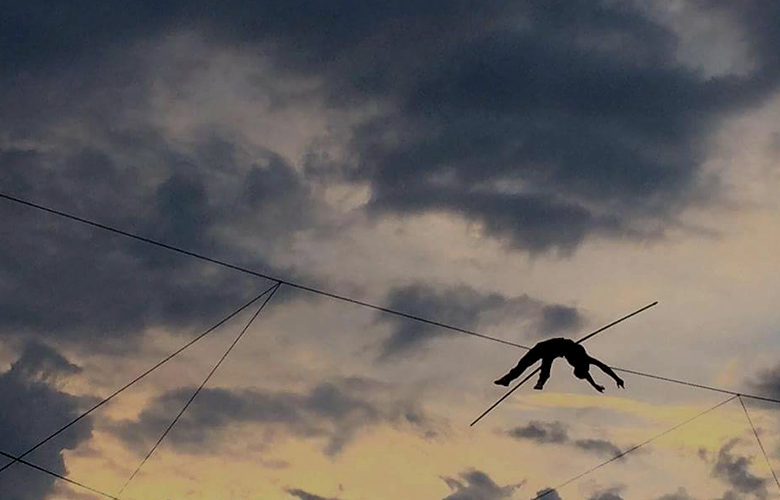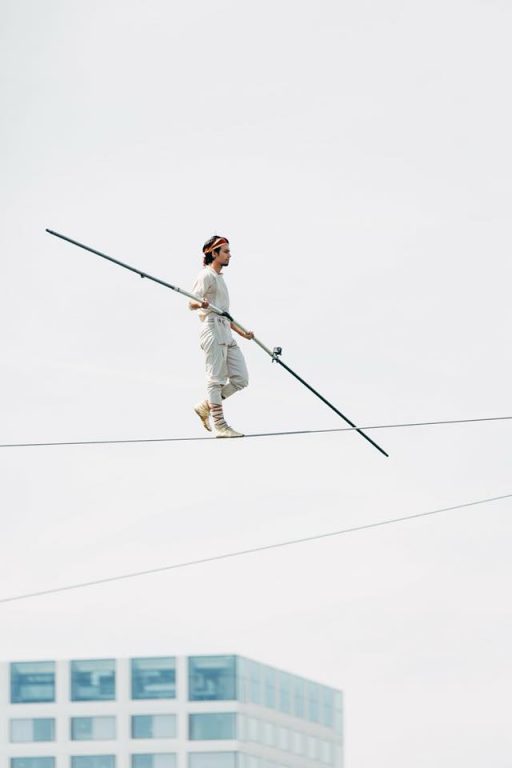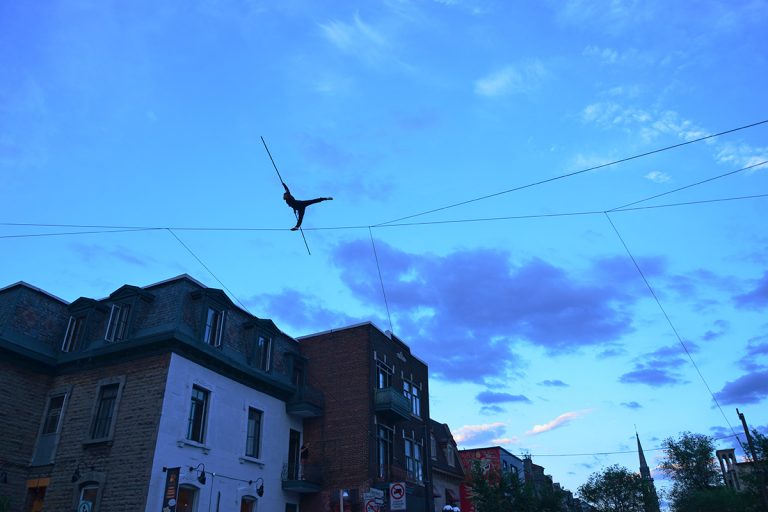
The most famous man to walk the streets of New York City in August 1974 gained notoriety simply by taking a walk… 546 meters (1791 feet) above them! A wire had been installed between the World Trade Center’s towers so that Philippe Petit, a French high wire walker, could complete the exploit that inspired the 3D movie The Walk 40 years later.
In more recent years, audiences around the United States were fascinated, their eyes lost in the Big Apple Circus’ dark blue sky, as the Wallendas were seemingly floating from one platform to the other, sometimes one on top of each other! In spite of the inclusion of high wire acts in contemporary circus productions and of their theatrical set-up, when it comes to the true nature of a performance and its inspiration, is a wire walker an artist or a stuntman?
“A poet! My aim is not to scare nor to impress. A high wire walk really is a spiritual journey where one must stay calm, focused. It’s that calmness that will somewhat hypnotize the audience and make them forget the risks behind such performance.”
“By walking between sky and earth, I want to wake people up, have them share a special moment as a community by connecting with the sky and each other.”
“I really have to let go of my ego, I must display vulnerability and openness to stay calm, to connect with the audience and successfully make it to the end of the wire, sometimes to be hugged by people moved to tears!”
Laurence Tremblay-Vu, a Montreal-born wire artist of Vietnamese origins, partly chose the nomadic life of a circus artist to emulate yogis and acquire their qualities: mental strength, inner balance and the ability to do unconventional things with the human body. His interest in circus arts initially came from the energy, mental control, concentration and focus that they require, but he ended up falling for the freedom and dance elements that he discovered on the more traditional tight wire, usually stretched about 2 meters above the ground (7 feet), half of a high wire’s minimal height.

His eyes are sparkling and moving frenetically as he describes the joy and fascination that came from exploring the wire in all possible ways and directions while training at the National Circus School, in Montreal:
“Practicing tight wire allowed me to be as free as a squirrel! By jumping, running, bouncing, going under, climbing on top and hanging from it, I discovered a world, an actual playground, of infinite possibilities!”
Laurence is also thankful to his wire practice for making him gain insight, awareness and philosophical growth through inner strength and balance, all developed over time. “Gaining confidence on the wire was a lengthy process and I am not ashamed to say that it only was about two to three years after graduating that I was able to feel true enjoyment in doing what I do up there.”
“The thing with wire and other balancing acts is that they are mainly about inner control, feeling and feeding off what’s inside. Therefore opening up to focus on outside elements, like the audience, is very hard and against the nature of your craft, quite a paradox since no performance is complete without an audience!”
Through touring Switzerland with a traveling circus, joining the multidisciplinary cast of an Opera in Quebec and sharing his dancing and acrobatic skills with German audiences, the 32-year old not only perfected his technique, but discovered how joyful and important playing and interacting with others were in his creative process and to his artistic growth.
“There is no greater pleasure than sharing my passion with an audience and I’m a firm believer that by being authentic on stage and allowing people to see your true self in every step, trick and intention are keys to a moving and inspiring performance.” He smiles, pauses, and adds “and that we really need to get out of our comfort zone as artists.”
That smile stays on his face when asked about his initial expectations in transitioning from one wire to the other one in high altitude: “OH I didn’t have any! It was my instinct screaming ‘You MUST try it!’”

Since high wire’s technique and secrets aren’t taught in circus schools, but traditionally shared within generations of circus families, the aspiring wire walker flew to Normandy to meet Denis Josselin who, for years, has been walking in the sky and trying to de-democratize his passion by literally passing the baton, here called a balancing pole, to a new generation. With the support of his mentor, Laurence ended his workshop by confidently crossing a 40 meters long wire, 9 meters above the Brussels-Charleroi Canal, in Belgium, with an audience at eyes height watching his every move from a bridge, “so it really wasn’t feeling that high!”
His first high wire encounter might be impossible to recall, but that Belgian crowd reminds him of a different bridge, in Quebec city, where the walk and art form entered his life in the most abstract way, years prior to his professional debuts: “I was heartbroken, walking along that bridge and there was something both peaceful and energizing about gazing into the void. It was the strongest and calmest moment I’ve ever experienced and, once I had reached the other end of the bridge, I was overwhelmed by the beauty of the void, by this feeling of freedom and of letting go that had grown within me with each step that I took. It was a very inspiring walk and, on a subconscious level, without wire shoes and a balance pole, my very first one on the high wire.”

By choice and by necessity, the balanced man never thinks about the possible dangers and falls that one could encounter in their next step. Both the length and height of the wire can influence his actions and state of mind in the days leading up to a performance. In the Spring of 2018, in preparation for his biggest challenge in his career, Laurence took a full week off to meditate, do yoga, prepare his body and envision how he’d walk, breathe and perform for an audience…25 meters above them! Some Swiss spectators referred to his performance in Basel as a phenomenon as they were gazing at the sky, watching the artist between the clouds. “I could feel a strong, united, almost mythical energy going through the people who were all sharing this moment of abstract beauty and light while opening up to the sky.”

With seven years of sky walking under his soles, the inspired artist can now reflect on the different rapport that wire walkers have with the audience. “Those who are crossing wires in traditional circuses and who are in it for the stunt are feeding off the audience’s fear by playing with danger and faking falls, where I, as an artist, am letting the spectators inspire and influence me with their presence and reactions. By finding new movements that are in the spirit of the walk and the tone of this sometimes enlightening, sometimes meditative performance, I can almost hide the walk and substitute it with more powerful images.”
High wire, tight wire. The two disciplines might share the same name and whilst it is clear for this wire walker that both have their uniqueness and appeal, they also could not be more different, artistically speaking.
The tight wire artist, closer to an acrobatic dancer, wows the audience with intricate choreography and combinations for claps and cheers, whilst the one on the high wire, more focused on the “here and now,” embodies grace and strength by doing very slow and controlled actions.
Looking back at his past performances at both heights, Laurence points out that, by doing a series of stunts that are easier to hide in the choreography, the tight wire dancer, whom people are expecting to see flip and jump, might seem to be a stunt man. Whereas the high wire walker’s approach may seem more artistically profound to some. Whether the wire is 2 or 12 meters high, both wire artists are trying to find the balance between art and stunt.
When Creativity And Motherhood Become Synonyms
Discipline: A Ballet Dancers Middle Name


Impassioned by performing arts, Martin Frenette started intensive dance training at a very young age before trading pliés and barres for ropes and somersaults at Montreal's National Circus School. He has spent a decade in Europe, performing in various productions. Circus Monti, Chamäleon Theater, Wintergarten Varieté, Cirque Bouffon, GOP Show Concepts, and the Friedrichsbau Varieté have allowed him to grow artistically and humanly. Martin has also invested time working as an artistic consultant, director, and choreographer for both circus and dance projects. He enjoys splitting his time between Europe, Canada, and the US, working on stage and creating for others. Writing has always been a big passion of his and he's thrilled to share his views on shows, the stage, and what's going on behind the scenes with other performing arts enthusiasts!
Read Full Profile© 2021 TheatreArtLife. All rights reserved.

Thank you so much for reading, but you have now reached your free article limit for this month.
Our contributors are currently writing more articles for you to enjoy.
To keep reading, all you have to do is become a subscriber and then you can read unlimited articles anytime.
Your investment will help us continue to ignite connections across the globe in live entertainment and build this community for industry professionals.